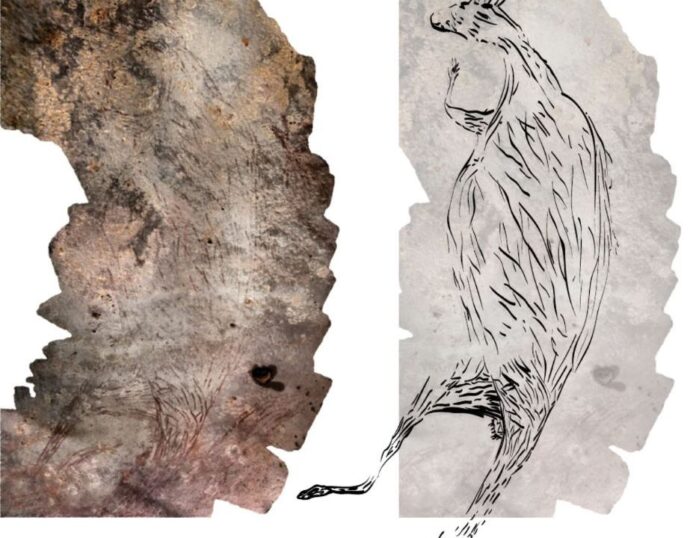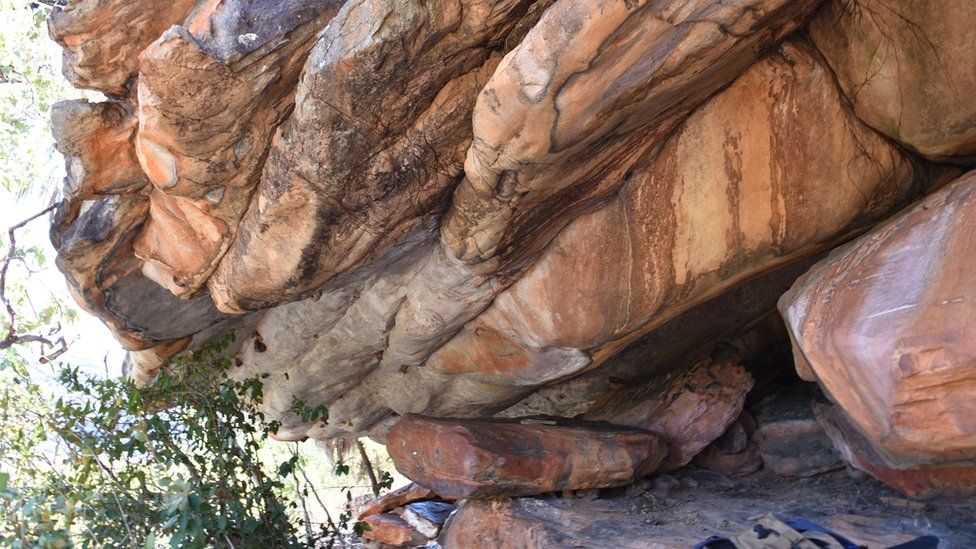
The kangaroo painting which was created over 17,000 years ago by Aboriginal artists, has been identified with a little help from some ancient wasps as Australia’s oldest extant rock art. The two-meter (six feet) painting on the sloped ceiling of a stone refuge in the Kimberley region of Western Australia was painted in an early naturalistic style, which often includes life-size images of animals.
Scientists have worked with the local Aboriginal community. They can trace their heritage in the region back tens of thousands of years, to establish the age of the original rock carvings, many of which have been worked and altered over the millennia.
The study’s lead author Damien Finch, a geochronologist at the University of Melbourne, said that the main problem with dating ancient paintings globally is that they very rarely used a pigment that could be dated using any of the modern quantitative dating methods.
To get around this problem, the researchers found a way to determine the age of the kangaroo painting using the nests of ancient mud wasps.
The researchers found that some of the Aboriginal rock paintings above and below the images contain remains of these nests. They estimated that the kangaroo painting was about 17000 years old, which is the oldest found to date.

Sissy Gore-Birch, head of the Balanggarra Aboriginal Corporation, said in a statement from the University of Western Australia that it is important that Aboriginal knowledge and stories are not lost and continue to be passed on for future generations.
She said the partnership could combine traditional knowledge with Western science, adding that the dating of the oldest known stone vault drawing is of great importance to Aboriginal people and Australians and is an important part of Australian history.
The team dated 27 mud wasp nests and about 16 different Aboriginal rock paintings from eight stone shelters. The team of researchers found that works of art in the same naturalistic style were made between about 17,000 and 13,000 years ago.

The images were mostly of animals, including a snake, a lizard-like figure, and three macropods – marsupials, including kangaroos, wallabies, and quokkas. Finch, in a statement, said it was an important find because with these initial assessments people can understand a thing or two about the world these ancient artists lived in. He also added that the environment would be cooler and drier than today.
According to Finch, we will never know what was in the mind of the artist when he created the kangaroo printing more than 600 generations ago, but we do know that the naturalistic period extended even before the Last Ice Age.
Study co-author Dr. Sven Uzman of the University of Western Australia added that there may be a link between the kangaroo image and ancient art from other regions.
He said this iconic kangaroo painting visually resembles rock paintings from islands in Southeast Asia dating back more than 40,000 years ago, suggesting a cultural connection and hinting at even more ancient rock art in Australia.
Earlier this year, researchers discovered on the island of Sulawesi, Indonesia, the world’s oldest animal rock art, a 45,000-year-old life-size pig.
In South Africa, the hashtag drawing, created 73,000 years ago, is considered the oldest known drawing.
Sissy Gore-Birch, Chairperson of the Balanggarra Aboriginal Corporation, noted the importance of discovering kangaroo rock art for Aboriginal people and Australians. She said that it is important that the knowledge and stories of indigenous peoples are not lost and continue to be passed on to future generations.
Aboriginal rock paintings

Aboriginal rock paintings are the oldest form of Australian indigenous art. The earliest specimens found at Gabarnmung in Arnhem Land date from about 28,000 years ago. It is believed that there are over 100,000 rock art sites in Australia, which constitute a unique archive of local art.
These sites are sacred to Australian aborigines as they are inhabited by the spirits of their ancestors. They should be respected as sacred sites that embody the artistic, social, environmental, and spiritual knowledge that are the lifeblood of Aboriginal culture.
Aboriginal rock paintings feature engravings and images of graphic symbols, human figures, tribal ceremonies, animals, plants, and ancestral spirits that control the forces of nature and space. Over the millennia, the oldest specimens of rock art created by prehistoric artists have been reworked and reevaluated by successive generations of local artists until the 20th century.
This creates an unusual artistic scenario, when a late Paleolithic artist begins a drawing, which is then redrawn by a Neolithic artist, and then by successive artists from the times of the Ancient Egyptians, Ancient Greeks, Early Christian and Byzantine eras, Dark Ages, Renaissance and all stages of art history up to the modern era.
If such a phenomenon existed in Western art, it would be appreciated and protected by future generations. Unfortunately, many Aboriginal rock paintings face multiple threats from natural erosion, such as pollution, vandalism, mining, development, and a lack of general maintenance and legal protection.

The earliest Aboriginal rock paintings convey visual information about the Aboriginal lifestyle. The engraved dot rings and animal footprints are typical of the most ancient examples. In a later period, we begin to see simple images of animals, fish, birds, and figurines of matches.
Hand stencils were often used to assert a tribe’s status or claim territory. The artist simply places his hand on the wall, takes a sip of pigment, and sprays it on his hand, leaving a negative print. Over time, the Aboriginal rock paintings became more sophisticated, incorporating more complex figures involved in common activities such as hunting, fishing, fighting, and trading.
























